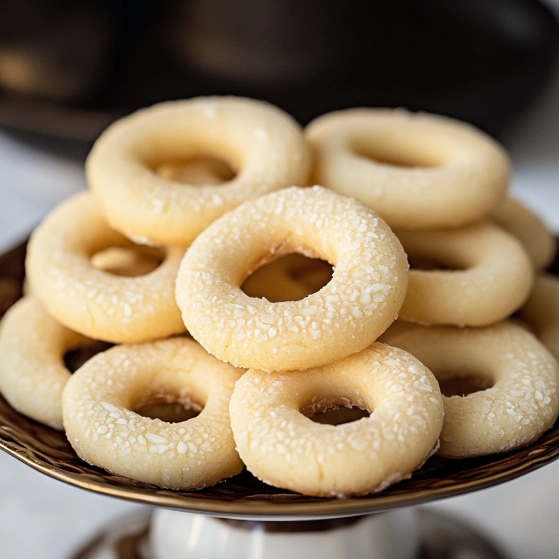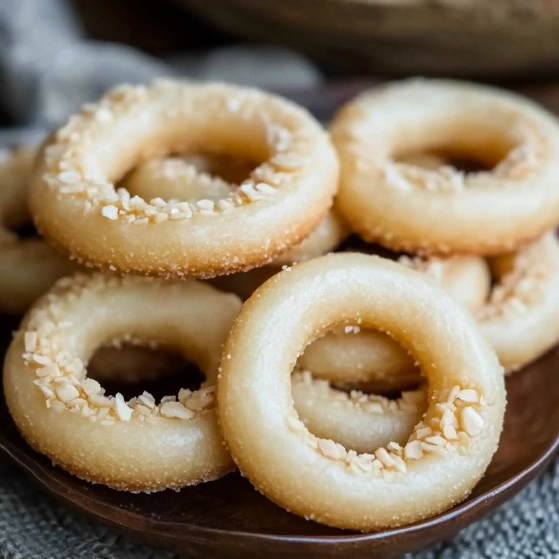 Pin it
Pin it
This delicate Tunisian almond ring cookie recipe has been in my family for generations, bringing the aromatic flavors of North Africa to our special occasions. Kaak Tunsi are buttery, crumbly cookies with a distinctive ring shape that makes them both beautiful and delicious.
I first learned to make these cookies from my Tunisian neighbor who insisted I master the perfect ring shape. After many practice sessions, these cookies became my signature contribution to every holiday gathering.
Ingredients
- Almond flour: Creates the distinctive sandy texture that makes these cookies special
- All purpose flour: Provides structure while keeping the cookies light
- Powdered sugar: Incorporates seamlessly for a smooth dough without graininess
- Unsalted butter: Adds richness and creates those delicious buttery layers
- Egg white: Works as a binding agent while keeping the texture light
- Orange blossom water: Brings authentic North African flavor that transports you to Tunisia
- Vanilla extract: Enhances the almond flavor without overpowering
- Salt: Balances the sweetness and enhances all other flavors
Step-by-Step Instructions
- Combine Dry Ingredients:
- Mix almond flour, all-purpose flour, powdered sugar, and salt in a large bowl until thoroughly combined. This foundation ensures even distribution of flavors throughout each cookie.
- Create the Butter Mixture:
- Add softened butter to your dry ingredients and work it in with your fingertips until the mixture resembles coarse crumbs. This technique creates pockets of butter that will make your cookies tender and flaky.
- Add Wet Ingredients:
- Pour in the egg white, orange blossom water, and vanilla extract. Gently mix and knead until a smooth, pliable dough forms. Do not overwork the dough or your cookies will become tough.
- Shape Your Rings:
- Take small portions of dough and roll into thin logs about 4 inches long and 1/2 inch thick. Bend each log into a circle, pinching the ends together and smoothing the seam with your fingers. The traditional ring shape is essential for authentic Kaak Tunsi.
- Bake with Care:
- Place your shaped rings on a parchment-lined baking sheet with adequate spacing. Bake in a preheated 300°F oven for 15 to 20 minutes. The low temperature ensures the cookies remain pale and maintain their delicate texture.
 Pin it
Pin it
The orange blossom water is my favorite ingredient in this recipe. Its subtle floral aroma reminds me of walking through the markets in Tunisia where vendors would offer tiny cups of mint tea alongside these delicate cookies. The scent fills my kitchen with memories every time I bake them.
The Art of Shaping
The ring shape of Kaak Tunsi is not just traditional but practical. The hole in the center ensures even baking and a consistent texture throughout. When forming your rings, aim for uniformity in thickness. If your dough becomes too warm while working with it, refrigerate for 15 minutes before continuing. This will make handling much easier and result in cleaner shapes.
 Pin it
Pin it
Storage Tips
Kaak Tunsi are excellent keepers and actually improve after a day or two as the flavors meld. Store in an airtight metal container with parchment paper between layers to prevent sticking. They will maintain their texture and flavor for up to two weeks at room temperature. For longer storage, freeze unbaked shaped cookies on a tray, then transfer to freezer bags. Bake directly from frozen, adding 2-3 minutes to the baking time.
Cultural Significance
These ring cookies hold deep cultural importance in Tunisia. They symbolize continuity and unity, which is why they frequently appear at weddings and celebrations. Traditionally, women would gather to make large batches together, sharing stories and passing down techniques through generations. The distinct shape and almond flavor set them apart from other North African cookies, making them instantly recognizable on any dessert platter.
Serving Suggestions
In Tunisia, Kaak Tunsi are traditionally served with mint tea in small glasses. The refreshing tea perfectly complements the nutty, buttery cookies. For a modern twist, pair them with espresso or Arabic coffee. They also make elegant accompaniments to fresh fruit or even a scoop of rosewater ice cream for a sophisticated dessert. The subtle sweetness makes them appropriate for breakfast, tea time, or after dinner.
Frequently Asked Questions
- → Can I substitute the orange blossom water in Kaak Tunsi?
Yes, you can substitute orange blossom water with rose water as mentioned in the ingredients list. If neither is available, you can use 1/2 teaspoon of lemon or orange zest mixed with a few drops of vanilla extract to achieve a similar aromatic quality.
- → Why is it important that Kaak Tunsi cookies remain pale?
The pale color is a traditional characteristic of authentic Kaak Tunsi. Browning would indicate overbaking, which would make them too crisp rather than maintaining their signature delicate, melt-in-your-mouth texture.
- → How long do Kaak Tunsi cookies stay fresh?
When stored in an airtight container at room temperature, Kaak Tunsi can stay fresh for up to 2 weeks. Their low moisture content helps with their longevity, making them a great make-ahead treat.
- → Can I freeze the dough for Kaak Tunsi?
Yes, the dough can be frozen for up to 1 month. Shape the dough into a disc, wrap tightly in plastic wrap, then place in a freezer bag. Thaw completely in the refrigerator before shaping and baking.
- → What makes almond flour different from regular flour in these cookies?
Almond flour provides a distinctive nutty flavor and creates the signature tender, crumbly texture that's characteristic of Kaak Tunsi. It also adds richness and moisture, resulting in cookies that are more delicate than those made with only all-purpose flour.
- → Are Kaak Tunsi cookies served on special occasions?
In Tunisia, these cookies are often prepared for special celebrations like Eid, weddings, and family gatherings. However, they're also enjoyed as everyday treats with afternoon tea or coffee in many Tunisian households.
